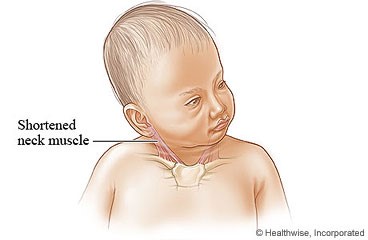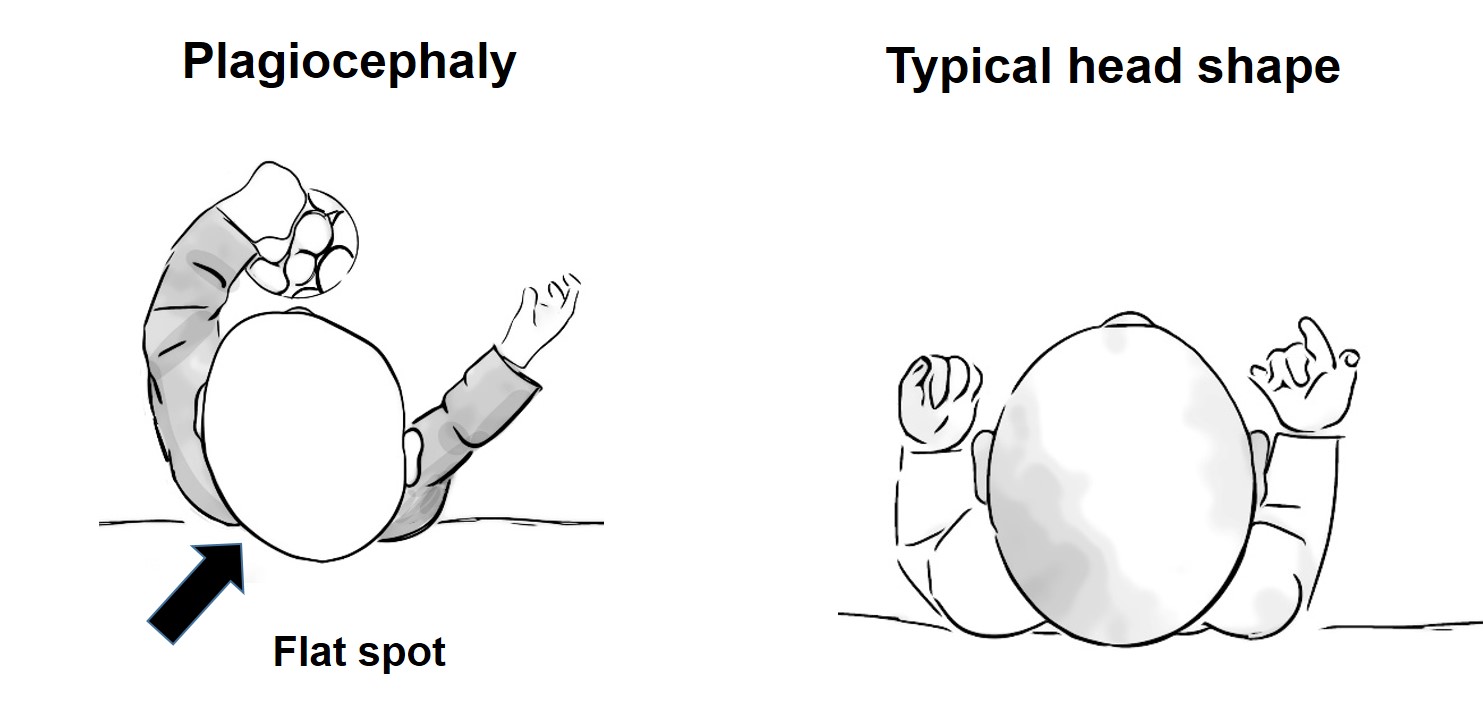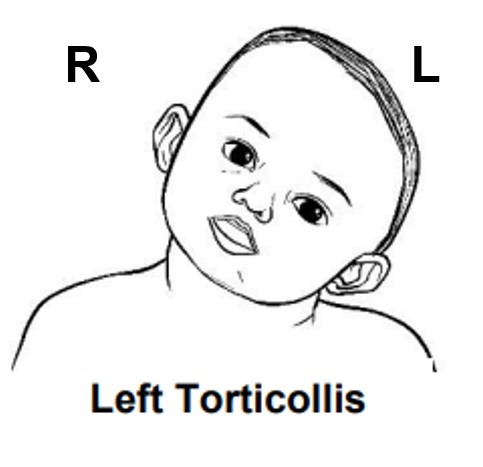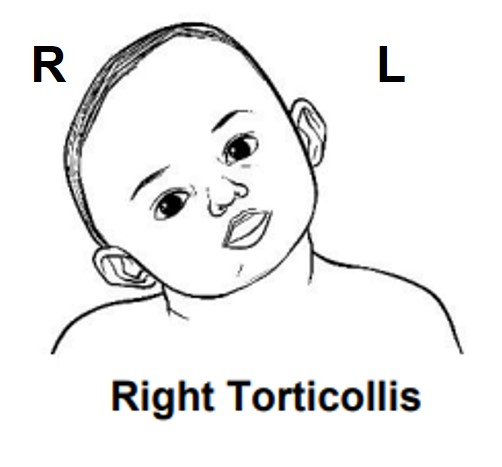Congenital Torticollis in Children
Care instructions

Congenital torticollis is a common condition in babies. It means your baby’s head is tilted to one side. The chin points to one shoulder, and the head tilts toward the other shoulder. It happens because a neck muscle is shortened. This does not cause pain.
You may notice:
- A lump in your baby's neck muscle. The lump usually goes away on its own by 6 months of age.
- Your baby may prefer to look to one side.
- Your baby may have difficulty feeding turned one way.
- Your baby may have a flat spot on one side of the back of the head, also known as plagiocephaly.
- Your baby’s cheeks, forehead and ears may appear unequal between sides.

Your baby needs treatment to improve their neck movement.
Be sure to see your doctor and pediatric physiotherapist for an examination. They will help you make a plan for the best treatment for your baby. Early treatment leads to the best results.
How can you care for your child at home?
- After your assessment with your doctor and physiotherapist, stretch your baby's tight neck muscle several times a day. Your physiotherapist will show you how to do this safely.
- Your physiotherapist will also show you strengthening activities and positioning to help your baby. This includes time with your baby on their stomach on a firm surface. This is known as "tummy time." This position helps your baby learn to lift their head. This strengthens and stretches your baby's neck muscles.
Positioning for left torticollis

With a left torticollis, the baby’s head will tilt to the left and turn to the right. The muscle on the left side of the neck is tight. To help correct the position we want to turn the baby’s head in the other direction, to the left.
Sleeping
- Place your baby’s head at the end of the crib that encourages them to look to the left side. Your baby will typically want to look out into the room or towards the door.
- Crib toys should be positioned so the baby is encouraged to look to the left side.
- Overhead hanging mobiles should be removed.
- When you check on your baby, gently turn their head to the left. You do not need to wake up in the night to change your baby’s head position.
- Don’t allow your baby to sleep in a car seat outside of the car, bouncy seat, or swing, unless advised by your doctor.
- Don’t use positioning devices, pillows, or towel rolls while your baby is sleeping.
Playing
- Lots of tummy time–start with a few minutes, several times a day. Place a rolled towel under their chest to make tummy time easier. When they are resting their head against the ground in tummy time, turn their head towards the left.
- Use side-lying on the left side as a supervised play position. Support your baby with a rolled towel behind the back and a small, rolled towel in front of the tummy.
- When playing on their back, encourage their head to be in the middle or looking to the left. You can use toys, your position, position of siblings, or other favourite objects to encourage looking to the left.
Car seat, swing, and bouncy chair
- Limit the time your baby spends in the swing and bouncy chairs. Use a sling or front baby carrier instead.
Feeding
- When bottle feeding, offer the bottle in midline, so your baby doesn’t turn their head. Maintain a good neutral head position with your supporting arm.
- If there are difficulties breastfeeding on one side, try using a football hold.
- In the highchair feed your baby from the middle or slightly to baby’s left.
Diaper Changes and Baths
- Position your baby on the change table and in the bath so that your baby turns their head to the left.
Positioning for right torticollis

With a right torticollis, the baby’s head will tilt to the right and turn to the left. The muscle on the right side of the neck is tight. To help correct the position we want to turn the baby’s head in the other direction, to the right.
Sleeping
- Place your baby’s head at the end of the crib that encourages them to look to the right side. Your baby will typically want to look out into the room or towards the door.
- Crib toys should be positioned so the baby is encouraged to look to the right side.
- Hanging mobiles should be removed.
- When you check on your baby, manually turn your baby’s head to the right. You do not need to wake up in the night to change your baby’s head position.
- Don’t allow your baby to sleep in a car seat outside of the car, bouncy seat, or swing, unless advised by your doctor.
- Don’t use positioning devices and towel rolls while your baby is sleeping.
Playing
- Lots of tummy time–start with a few minutes, several times a day. Place a rolled towel under their chest to make tummy time easier. When they are resting their head against the ground in tummy time, turn their head towards the right.
- Use side-lying on the right side as a supervised play position. Support your baby with a rolled towel behind the back and a small, rolled towel in front of the tummy.
- When playing on their back, encourage their head to be in the middle or looking to the right. You can use toys, your position, position of siblings, or other favourite objects to encourage looking to the right.
Car seat, swing, and bouncy chair
- Limit the time your baby spends in the swing and bouncy chairs. Use a sling or front baby carrier instead.
Feeding
- When bottle feeding, offer the bottle in midline, so your baby doesn’t turn their head. Maintain a good neutral head position with your supporting arm.
- If there are difficulties breastfeeding on one side, try using a football hold.
- In the highchair feed your baby from the middle or slightly to baby’s right.
Diaper changes and baths
- Position your baby on the change table and in the bath so that your baby turns their head to the right.
When should you call for help?
Watch closely for changes in your baby's health, and be sure to contact your doctor or nurse advice line if:
- Your child does not improve after a few months of treatment at home and with your physiotherapist.
To see this information online and learn more, visit MyHealth.Alberta.ca/health/aftercareinformation/pages/conditions.aspx?hwid=custom.ab_congenital_torticollis_inst_child.

For 24/7 nurse advice and general health information call Health Link at 811.
Current as of: August 23, 2023
Author: Pediatric Rehabilitation Services, Alberta Health Services
This material is not a substitute for the advice of a qualified health professional. This material is intended for general information only and is provided on an "as is", "where is" basis. Although reasonable efforts were made to confirm the accuracy of the information, Alberta Health Services does not make any representation or warranty, express, implied or statutory, as to the accuracy, reliability, completeness, applicability or fitness for a particular purpose of such information. Alberta Health Services expressly disclaims all liability for the use of these materials, and for any claims, actions, demands or suits arising from such use.
